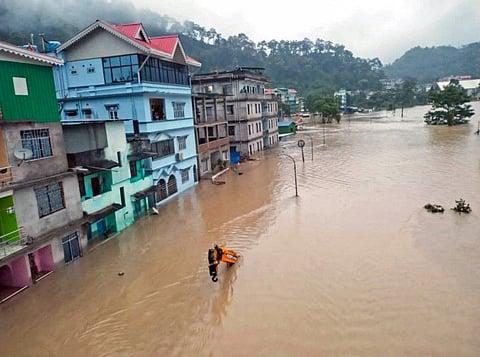Floods in India’s Sikkim state leave 10 dead, 82 missing, including 23 Army personnel
Heavy rain to continue; landslides, flight disruptions possible

GUWAHATI/NEW DELHI: At least ten people were killed in India’s state of Sikkim and 82 others, including 23 army personnel, were missing after heavy rainfall caused the glacial Lhonak lake to overflow, spurring catastrophic flooding in the region on Wednesday, officials said.
The northeastern state received 40.9 mm of rainfall between Tuesday and Wednesday morning, according to the India Meteorological Department (IMD) - almost five times its normal rate of 8.6 mm for this time of the year.
“So far, 10 bodies have been recovered from different locations. At least 82 more are missing and 22 people are injured, some of them seriously,” Sikkim Chief Secretary V B Pathak told Reuters.
A cloudburst - or an extreme amount of rain over a brief period of time - over Lhonak lake triggered the torrential flooding in the valley located about 150 km (93 miles) north of Gangtok near the border with China.
“Intense rain has led to this catastrophic situation in Sikkim where the rain has triggered a glacial lake outburst flood and damaged a dam and caused loss of life and caused further damage to roads and infrastructure,” said Miriam Jackson, a senior cryosphere specialist at the Nepal-based International Centre for Integrated Mountain Development.
Heavy rainfall hampered the search for the Indian troops reported missing, with the capital city of Gangtok cut off by road, defence officials said.
“Twenty three personnel have been reported missing and some vehicles are reported submerged under the slush. Search operations are underway,” a defence ministry spokesperson said.
India’s weather department has warned of landslides and disruption to flights as heavy rain is predicted to continue over the next two days in some parts of Sikkim.
Jackson warned that such extreme events have become more frequent “as the climate continues to warm and takes us into unknown territory.” The main highway linking Sikkim to West Bengal state had collapsed and Gangtok was totally cut off by road, according to army spokesperson Anjan Basumatary.
About 15,000 people living in the vicinity are likely to be affected and at least eight major bridges have been washed away along the banks of the Teesta river, officials said.
Media showed images of the river lashing through the hills and entering residential areas.
Some army bases and facilities along the valley were affected and rising water submerged vehicles following the release of water from a dam, a defence ministry spokesperson based in the neighbouring city of Guwahati said.
Intermittent rain and thunderstorms were hampering rescue operations in the area, an army official told Reuters, speaking on condition of anonymity.
Prime Minister Narendra Modi said he “assured all possible support” for those impacted.
“Intense rain has led to this catastrophic situation in Sikkim where the rain has triggered a glacial lake outburst flood and damaged a dam, and caused loss of life”, said Miriam Jackson, a scientist specialising in ice who monitors Himalayan regions.
“We observe that such extreme events increase in frequency as the climate continues to warm and takes us into unknown territory”, Jackson added, in a statement from the International Centre for Integrated Mountain Development (ICIMOD) research group.
Himalayan glaciers are melting faster than ever due to climate change, exposing communities to unpredictable and costly disasters, according to the Nepal-based ICIMOD.
Earth’s average surface temperature has risen nearly 1.2 degrees Celsius since preindustrial times, but high-mountain regions around the world have warmed at twice that pace, climate scientists say.
The Sikkim region is also hit annually by flash floods during the monsoon rains, which begin in June and normally withdraw from the Indian subcontinent by the end of September. By October, the heaviest of the monsoon rains are usually over.
Melting glaciers add to the volume of water while unregulated construction in flood-prone areas exacerbates the damage.
Sign up for the Daily Briefing
Get the latest news and updates straight to your inbox



